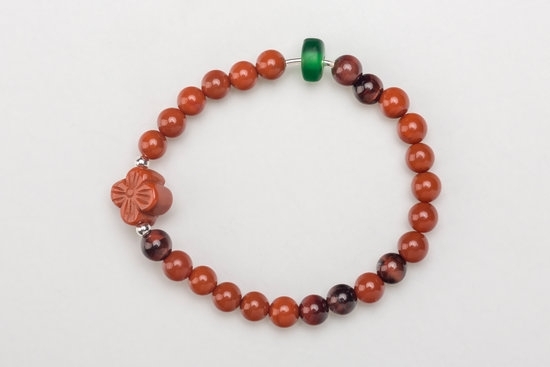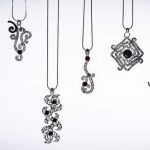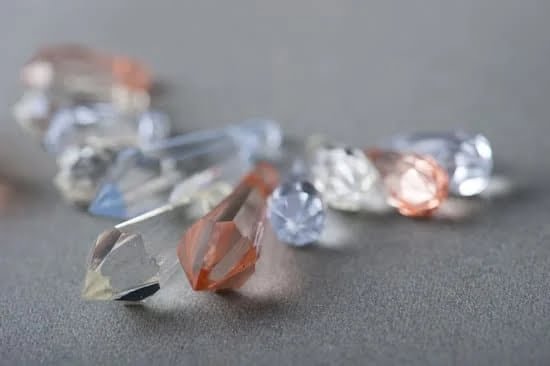The history of micro mosaic glass jewelry dates back to ancient times, with a rich and intricate evolution over the centuries. From its origins in Ancient Rome to its revival during the Renaissance and its modern-day resurgence, micro mosaic glass jewelry has captivated art enthusiasts with its meticulous craftsmanship and stunning designs.
Tracing its roots back to Ancient Rome, micro mosaic glass jewelry has always been revered for its exquisite beauty and attention to detail. The process of creating these intricate pieces involves selecting the tiniest glass pieces and arranging them into stunning designs, showcasing the skill and dedication of the artisans behind the craft.
The art form experienced a revival during the 18th and 19th centuries, garnering popularity among European nobility. Its significance in cultural exchange and souvenir collecting reached new heights during the Grand Tour era, often seen as a symbol of status and sophistication. Despite experiencing a decline in the 20th century, micro mosaic glass jewelry has recently made a resurgence as a coveted art form, with contemporary artists continuing to innovate and push boundaries in their designs.
The Origins
Micro mosaic glass jewelry has a rich and fascinating history that dates back to ancient Rome. The intricate art form of creating micro mosaic jewelry can be traced back to the 3rd century BC, when Roman artisans began crafting small, colorful glass pieces to decorate their homes and personal belongings. These early examples of micro mosaic art laid the foundation for the stunning jewelry pieces that would become popular in later centuries.
The technique of creating micro mosaic glass jewelry involves carefully selecting tiny glass pieces, known as tesserae, and arranging them into intricate designs. The level of precision and attention to detail required for this process is truly remarkable, and it speaks to the skill and artistry of the craftsmen who have practiced this tradition throughout history.
As time passed, micro mosaic glass jewelry continued to evolve and gain popularity across Europe. During the Renaissance period, particularly in the 18th and 19th centuries, micro mosaic jewelry experienced a revival, becoming highly sought after among European nobility. The technique was refined and perfected during this time, leading to the creation of some of the most exquisite and luxurious micro mosaic pieces in history.
The influence of micro mosaic glass jewelry can also be seen during the Grand Tour era, a period from the late 17th century to the early 19th century when wealthy Europeans embarked on extended trips across Europe. Micro mosaics became cherished souvenirs collected during these tours, serving as tangible reminders of the artistic and cultural experiences encountered during travel.
This era marked a golden age for micro mosaic glass jewelry production, with artists producing an array of breathtaking designs that captured the imagination of collectors across Europe.
The Technique
Micro mosaic glass jewelry is a stunning art form that requires an incredibly meticulous process to create. The technique involves selecting the tiniest pieces of colored glass, known as tesserae, and arranging them into intricate designs to form a beautiful piece of jewelry. This art form dates back to ancient Rome, where it was used to decorate homes and public buildings, but it wasn’t until the 18th century that it gained popularity as a form of jewelry.
Selecting the Tesserae
The first step in creating micro mosaic glass jewelry is selecting the tiny tesserae that will be used in the design. These glass pieces are often less than 1mm in size and come in a wide range of colors. Artisans carefully choose each tesserae based on its color, shape, and size to ensure they can accurately depict their intended design.
Arranging the Design
Once the tesserae have been selected, they are meticulously arranged to create the desired design. This process requires immense skill and precision, as even the slightest misplacement can affect the overall appearance of the piece. Artists use special tweezers and tools to carefully place each tiny piece into position, creating a cohesive and detailed image.
Setting the Tesserae
After the design has been arranged, the tesserae are set into place using a special adhesive. Once secured, the entire piece is then heated to ensure that all of the glass pieces are firmly attached. This final step not only ensures that the design will remain intact but also adds depth and shine to the finished piece.
The technique of creating micro mosaic glass jewelry is truly an art form that requires patience, skill, and precision. From selecting the smallest glass pieces to arranging them into stunning designs, this intricate process has captivated artists and collectors for centuries.
The Renaissance Revival
During the 18th and 19th centuries, micro mosaic glass jewelry experienced a resurgence in popularity, particularly among European nobility. This revival was fueled by a growing interest in classical art and architecture, leading to a renewed appreciation for the intricate craft of micro mosaic glass jewelry. The technique of creating these miniature works of art was celebrated for its ability to capture the grandeur and detail of classical mosaics on a much smaller scale.
Key points to consider regarding the Renaissance revival of micro mosaic glass jewelry include:
- Increased demand among European aristocracy: The resurgence of micro mosaic glass jewelry coincided with a period of cultural renaissance in Europe, leading to a heightened interest in collecting and wearing pieces that were reminiscent of ancient Roman art and architecture.
- Italian influence: Italy played a central role in this revival, as it was home to skilled artisans who had mastered the meticulous art of creating micro mosaic designs. Rome, in particular, became a hub for the production and trade of micro mosaic jewelry, attracting collectors and connoisseurs from across Europe.
- Patronage and royal endorsements: The revival of micro mosaic glass jewelry received patronage from royal courts and noble families, further solidifying its status as a coveted luxury item. Notable figures such as Queen Victoria of England and Empress Eugenie of France were known for their affinity towards micro mosaic jewelry, contributing to its popularity among the upper echelons of society.
This period marked an important chapter in the history of micro mosaic glass jewelry, shaping its identity as an emblem of elegance and sophistication among the elite circles of Europe. As we explore this era, it becomes evident that the craftsmanship and artistry behind micro mosaic glass jewelry continue to captivate audiences through its timeless allure.
The Golden Age
During the Grand Tour, travelers would visit Italy and other parts of Europe to immerse themselves in art, culture, and history. As part of their journey, they would collect mementos and souvenirs to bring back home. Micro mosaic glass jewelry, with its exquisite craftsmanship and intricate designs, quickly became one of the most coveted items among Grand Tourists. These pieces often depicted famous landmarks like the Colosseum, St. Peter’s Basilica, or scenes inspired by classical mythology.
The significance of micro mosaic glass jewelry during the Golden Age extends beyond its popularity as a souvenir. These pieces served as tangible symbols of cultural exchange and appreciation for Italian artistry. Moreover, they represented a connection to ancient Roman techniques and aesthetics, further adding to their allure. Today, these historic pieces from the Golden Age continue to be prized by collectors and enthusiasts alike for their artistic merit and historical significance.
| Golden Age Facts | Significance |
|---|---|
| Peak production during the Grand Tour era | Symbolized cultural exchange |
| Souvenirs for Grand Tourists | Connection to ancient Roman techniques |
The Decline and Resurgence
The decline of micro mosaic glass jewelry in the 20th century marked a significant shift in the cultural and artistic landscape. With changing tastes and the emergence of new materials and techniques, traditional craftsmanship faced a decline in popularity. Mass production and industrialization also contributed to the dwindling presence of micro mosaic glass jewelry in the market.
However, in recent years, there has been a resurgence of interest in this exquisite art form. Collectors, connoisseurs, and enthusiasts have rediscovered the beauty and craftsmanship of micro mosaic glass jewelry, leading to a renewed appreciation for its intricate designs and historical significance. This revival has sparked a growing demand for authentic vintage pieces as well as modern interpretations created by contemporary artists and designers.
One reason for the resurgence of micro mosaic glass jewelry is its unique aesthetic appeal and timeless charm. The labor-intensive process involved in creating these miniature masterpieces adds to their allure, making them highly sought after by collectors and jewelry enthusiasts alike. Additionally, the revival of interest in traditional crafts and artisanal techniques has contributed to the renewed popularity of micro mosaic glass jewelry as consumers seek out unique, handcrafted pieces with historical significance.
| Decline Period | Resurgence Period |
|---|---|
| Influence of mass production and industrialization | Rediscovery of historical significance |
| Declining demand for traditional craftsmanship | Renewed appreciation for intricate designs |
| Shift in cultural and artistic preferences | Growing demand for vintage pieces and modern interpretations |
Notable Pieces and Artists
Micro mosaic glass jewelry has a rich and fascinating history, with notable pieces and talented artists contributing to its allure over the centuries. From its origins in Ancient Rome to its resurgence in contemporary art, micro mosaic glass jewelry has captivated enthusiasts and collectors alike. Here are some iconic examples of micro mosaic glass jewelry, along with the talented artists who have made significant contributions to this intricate art form:
- Portrait of Queen Victoria: One notable piece of micro mosaic glass jewelry is a portrait of Queen Victoria, created during the 19th century. This stunning portrayal of the British monarch showcases the precision and artistry involved in micro mosaic work.
- Floral Brooch by Giuliana Rancati: Giuliana Rancati is a renowned artist known for her exquisite micro mosaic jewelry designs. One of her standout pieces is a floral brooch, featuring vibrant colors and meticulous detailing that exemplify the beauty of micro mosaic art.
These examples represent just a fraction of the remarkable pieces that have been created throughout the history of micro mosaic glass jewelry. The skilled artisans behind these artworks have elevated micro mosaic to a level of unparalleled craftsmanship, making it a sought-after collector’s item and a celebrated form of artistic expression.
Whether it’s historical artifacts or modern masterpieces, micro mosaic glass jewelry continues to enthrall audiences with its timeless beauty and impeccable craftsmanship. The dedication and talent of the artists who bring these intricate designs to life ensure that the legacy of micro mosaic glass jewelry will endure for generations to come.
Modern Interpretations
In conclusion, the history of micro mosaic glass jewelry is a testament to the enduring appeal and timeless beauty of this intricate art form. From its origins in Ancient Rome to its resurgence in contemporary times, micro mosaic glass jewelry has captivated people with its meticulous craftsmanship and breathtaking designs. The technique involved in creating these miniature masterpieces, from selecting the tiniest glass pieces to arranging them into stunning patterns, continues to inspire artists and designers today.
Despite experiencing a decline in the 20th century, micro mosaic glass jewelry has seen a remarkable resurgence in recent years, with contemporary artists and designers pushing the boundaries of this art form. By incorporating modern materials and techniques, they are breathing new life into an age-old tradition and adapting it to suit the tastes of a new generation.
This innovative approach ensures that the legacy of micro mosaic glass jewelry continues to thrive in the ever-evolving world of fashion and design.
As we look back on the rich history of micro mosaic glass jewelry, it is evident that its allure has stood the test of time. From its origins in Ancient Rome to its modern interpretations today, this art form continues to enchant and inspire admirers around the world. With its fascinating past as a foundation, micro mosaic glass jewelry remains an enduring symbol of creativity and craftsmanship that will continue to captivate for generations to come.
Frequently Asked Questions
What Is the History of Micro Mosaic Jewelry?
The history of micro mosaic jewelry dates back to the 18th century in Italy. It became popular during the Grand Tour era when wealthy Europeans would travel to Italy and bring back these intricate pieces as souvenirs.
How Do You Date Micro Mosaic Jewelry?
Dating micro mosaic jewelry can be challenging, but examining the style, materials, and techniques used can provide clues. For example, earlier pieces may have larger tesserae (mosaic pieces) and simpler designs compared to later ones.
What Is the History of Glass Mosaics?
The history of glass mosaics can be traced back to ancient Mesopotamia and Egypt. However, it was the Romans who elevated the art form, using glass tesserae to create stunning floor and wall mosaics in their buildings and villas throughout the empire.

Welcome to my jewelry blog! My name is Sarah and I am the owner of this blog.
I love making jewelry and sharing my creations with others.
So whether you’re someone who loves wearing jewelry yourself or simply enjoys learning about it, be sure to check out my blog for insightful posts on everything related to this exciting topic!





